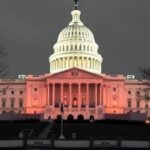In a stark warning that underscores the fragility of the nation’s fiscal health, the Congressional Budget Office (CBO) has projected that the recent monthlong Government shutdown could inflict up to $14 billion in lost economic output on the U.S. economy. This estimate, released amid ongoing debates over federal spending, highlights the immediate and cascading effects of halted government operations, with economists sounding alarms that the true toll might climb even higher due to indirect repercussions.
The shutdown, triggered by partisan disagreements over border security funding, paralyzed non-essential federal services for 35 days, affecting over 800,000 federal workers and countless contractors. As the CBO delves into the numbers, the report paints a picture of diminished productivity, delayed projects, and strained consumer confidence, all chipping away at the broader economic output.
CBO’s In-Depth Analysis Reveals $14 Billion Hit to GDP
The CBO’s comprehensive report, titled ‘The Effects of the 2018-2019 Government shutdown on Economic Output,’ meticulously breaks down the financial fallout from the impasse. According to the analysis, the direct lost output from furloughed employees and suspended agency activities alone accounts for a significant portion of the $14 billion figure. Federal workers, many of whom went without paychecks during the holiday season, saw their spending power evaporate, leading to a ripple effect across retail and service sectors.
Economists at the CBO employed sophisticated modeling to quantify these losses, factoring in reduced government spending on contracts and grants. ‘The shutdown disrupted normal economic activity in ways that are hard to fully capture,’ noted CBO Director Phillip Swagel in the report’s foreword. The agency’s projections indicate a 0.3% to 0.6% drag on fourth-quarter GDP growth, depending on the duration and severity of the disruptions. This isn’t just about the immediate halt; the CBO emphasizes that backlogs in processing permits, inspections, and data releases could prolong the economic drag into subsequent quarters.
Delving deeper, the report highlights sector-specific impacts. For instance, the Department of Agriculture’s suspension of loan programs delayed aid to farmers already battered by trade wars, potentially costing billions in agricultural output. Similarly, the National Park Service’s closure led to an estimated $500 million loss in tourism revenue, as visitors steered clear of shuttered landmarks like Yosemite and the Grand Canyon. These examples illustrate how the Government shutdown‘s tentacles reached far beyond Washington, D.C., squeezing economic output nationwide.
To put the $14 billion in perspective, that’s roughly equivalent to the annual GDP of a mid-sized U.S. city like Richmond, Virginia. The CBO’s methodology, which incorporates data from previous shutdowns in 1995-1996 and 2013, underscores the escalating costs of these political standoffs. Back then, losses were in the hundreds of millions; today, with a larger federal budget and more interconnected economy, the stakes are exponentially higher.
Federal Budget Strains Amplify Shutdown’s Economic Toll
Beyond the headline-grabbing $14 billion lost output, the government shutdown has exposed deep fissures in the federal budget framework, forcing lawmakers to confront unsustainable spending patterns. The CBO warns that emergency backpay measures for affected employees—totaling over $3 billion—will further balloon the deficit, already projected to hit $1 trillion this fiscal year. This infusion of funds, while necessary to prevent widespread financial hardship, diverts resources from critical infrastructure and social programs.
The federal budget’s rigidity played a pivotal role in the shutdown’s severity. With discretionary spending capped under the 2011 Budget Control Act, negotiations over the $5.7 billion for border wall construction became a flashpoint. As federal agencies like the IRS and FDA operated on skeleton crews, routine operations ground to a halt, leading to delayed tax refunds and slowed drug approvals. ‘This isn’t just lost output; it’s a self-inflicted wound on our fiscal stability,’ said Maya MacGuineas, president of the Committee for a Responsible Federal Budget, in a recent interview.
The shutdown’s budget implications extend to long-term federal liabilities. Unpaid contractors, including those in defense and environmental services, face cash flow crises that could result in lawsuits and additional taxpayer burdens. The CBO estimates that resolving these claims might add another $1-2 billion to the federal budget’s woes. Moreover, the episode has reignited debates over raising the debt ceiling, with projections showing it could be breached as early as mid-2019 without action.
In a broader context, the CBO’s findings tie into ongoing concerns about the federal budget’s trajectory. With mandatory spending on entitlements like Social Security and Medicare consuming 70% of the budget, discretionary cuts become inevitable battlegrounds. The shutdown serves as a cautionary tale: political brinkmanship not only erodes economic output but also undermines public trust in government’s ability to manage finances responsibly.
Economists Predict Even Greater Losses Beyond CBO’s Estimate
While the CBO’s $14 billion figure provides a sobering baseline, leading economists argue that the actual economic output losses could surpass this by a wide margin, factoring in intangible and multiplier effects. Mark Zandi, chief economist at Moody’s Analytics, has forecasted potential damages up to $20 billion when accounting for reduced consumer spending and business investments stalled by uncertainty. ‘The shutdown’s shadow lingers; businesses held off on hiring and expansions, creating a multiplier effect that the CBO’s direct measures might understate,’ Zandi explained during a panel at the American Economic Association’s annual meeting.
Independent analyses corroborate this view. A report from the U.S. Chamber of Commerce pegs small business losses at $6 billion, driven by disrupted federal contracts and supply chain interruptions. In the housing market, the suspension of FHA loan processing delayed thousands of closings, contributing to a dip in construction activity. Economists point to the 2013 shutdown, where initial estimates of $24 billion in losses proved conservative as subsequent data revealed deeper scars on economic output.
Global ramifications add another layer. With the U.S. dollar’s status as the world’s reserve currency, the shutdown rattled international markets, leading to a temporary spike in Treasury yields and a 1.5% drop in the S&P 500 during the impasse. International Monetary Fund (IMF) officials have warned that repeated U.S. fiscal disruptions could erode confidence in American institutions, indirectly hiking borrowing costs and pressuring economic output worldwide.
Demographic impacts are particularly acute. Low-income federal workers, many in service roles, faced food insecurity and relied on food banks, exacerbating inequality. A study by the Urban Institute estimates that the shutdown pushed 10 million Americans closer to poverty thresholds, with lost wages totaling $11 billion across all affected households. These human costs translate into reduced economic participation, as families cut back on education and healthcare spending to make ends meet.
Affected Workers and Sectors Face Prolonged Recovery Challenges
The human element of the government shutdown cannot be overstated, as stories from furloughed workers reveal the personal toll behind the macroeconomic statistics. Coast Guard personnel, working without pay to ensure maritime safety, resorted to crowdfunding for basic needs, while Smithsonian curators watched irreplaceable artifacts sit unmonitored. These anecdotes highlight how the 35-day standoff disrupted lives and livelihoods, contributing to the CBO’s tallied lost output.
Sectoral breakdowns show uneven recovery paths. The travel and tourism industry, hit hard by park closures, reported a 10% revenue drop in January, per the U.S. Travel Association. Airlines like Delta and American waived fees for stranded federal employees, but the broader sector lost an estimated $1.2 billion in bookings. In technology and research, NASA’s postponement of satellite launches delayed commercial partnerships worth hundreds of millions, stalling innovation pipelines.
Recovery efforts are underway, but challenges persist. The Treasury Department’s expedited backpay processing has helped, yet many contractors await reimbursement, leading to layoffs in support industries. Labor economists predict a ‘recessionary hangover’ effect, where cautious spending lingers for months, further eroding economic output. Union leaders like American Federation of Government Employees President David Cox have called for shutdown insurance funds in future budgets to mitigate such risks.
Environmental and health sectors bore unique burdens. The EPA’s halted monitoring contributed to unchecked pollution incidents, while the CDC’s delayed flu vaccine distribution strained public health responses. These lapses not only incur cleanup costs but also long-term economic drags through health crises and regulatory backlogs.
Path Forward: Rebuilding Economic Resilience Post-Shutdown
As Congress moves to avert future crises with a proposed budget deal extending funding through March 2020, the focus shifts to mitigating the shutdown’s enduring scars on economic output. Lawmakers are eyeing bipartisan reforms, such as automatic continuing resolutions to prevent abrupt halts, which could safeguard the federal budget from political volatility. The CBO recommends enhanced contingency planning, including diversified funding streams for essential services.
Economists advocate for stimulus measures to offset lost output, potentially through infrastructure investments that create jobs and boost GDP. The Federal Reserve, monitoring inflation and employment, may adjust interest rates downward if recovery falters, signaling a proactive stance against recession risks. ‘We’ve dodged a bullet, but the economy’s vulnerability to fiscal cliffs demands structural changes,’ opined Federal Reserve Chair Jerome Powell in recent testimony.
Looking ahead, the episode underscores the need for fiscal discipline amid rising deficits. With the 2020 election looming, candidates from both parties are pledging balanced budgets, though experts remain skeptical without concrete entitlement reforms. International allies, via forums like the G20, urge the U.S. to stabilize its fiscal posture to support global growth. Ultimately, rebuilding economic resilience will require bridging partisan divides, ensuring that government shutdowns become relics of a more divided past rather than harbingers of future turmoil.
In the coming months, quarterly GDP reports will provide clearer insights into the shutdown’s full impact, guiding policymakers toward sustainable strategies. For now, the $14 billion warning from the CBO serves as a clarion call: fiscal irresponsibility exacts a heavy price on America’s economic vitality.









